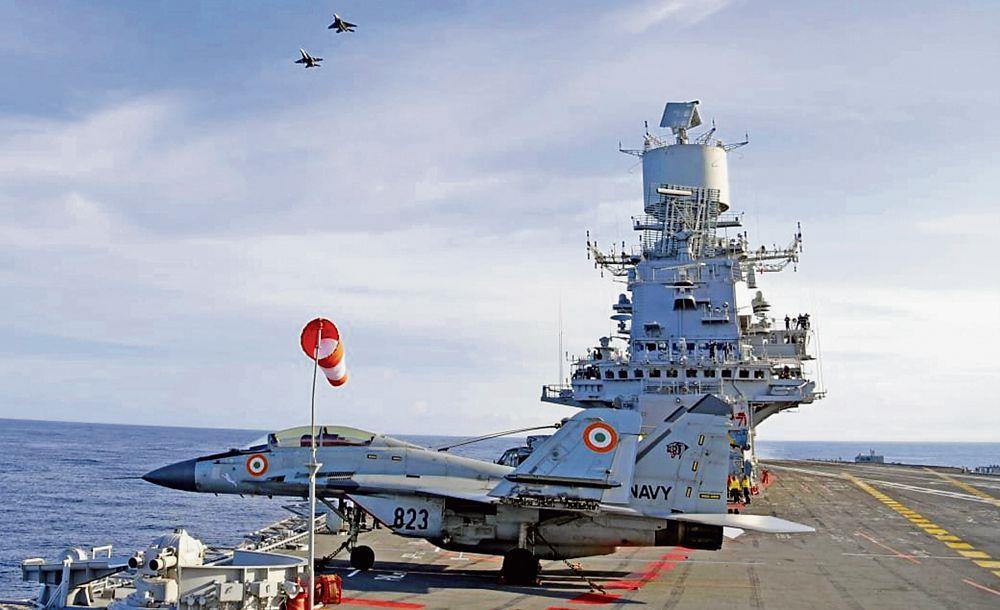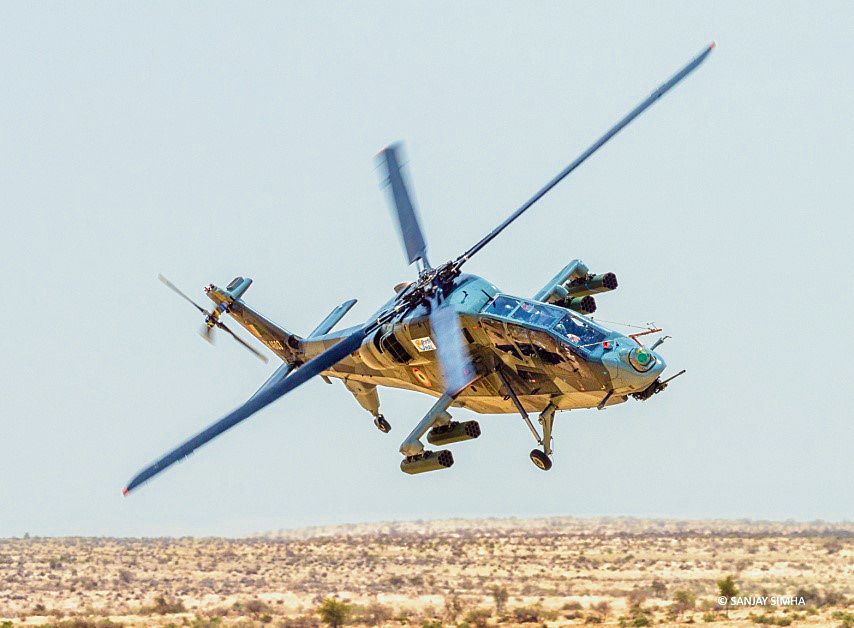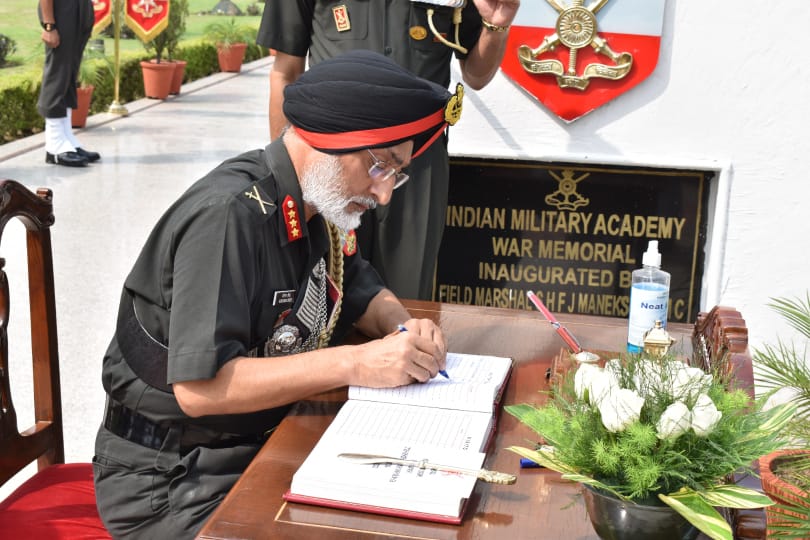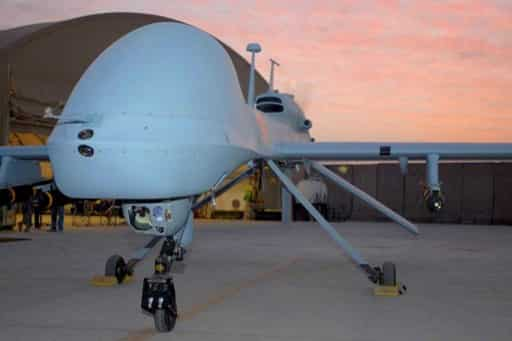











The Indian Navy will get a new ensign -– the flag that is hoisted atop all naval warships, ground stations and naval air bases. This is the fourth time since 1950 that the naval ensign will undergo a change. – PTI file photo
New Delhi, August 30
The Indian Navy will get a new ensign -– the flag that is hoisted atop all naval warships, ground stations and naval air bases. This is the fourth time since 1950 that the naval ensign will undergo a change.
“During the event, the Prime Minister will also unveil the new Naval Ensign (Nishaan), doing away with the colonial past and befitting the rich Indian maritime heritage,” the Prime Minister’s Office said in statement on Tuesday.On 26 January 1950, when India became a republic, the Navy crest and flags were changed to represent an independent India. Part of the flag retained the British legacy — the red colour Saint George’s Cross.

The Indian Air Force (IAF) is to raise its first unit of indigenously made Light Combat Helicopters (LCHs) in October. The LCH is made by Hindustan Aeronautics Limited (HAL).
New Delhi, August 30
The Indian Air Force (IAF) is to raise its first unit of indigenously made Light Combat Helicopters (LCHs) in October. The LCH is made by Hindustan Aeronautics Limited (HAL).
The IAF will be inducting 10 LCHs in the first batch.
The IAF operates the three-decade-old Russian Mi-25 and Mi-35 attack helicopters. One of the squadrons of the Russian-made copters is to be phased out while another one is going for a midlife upgrade. The process of induction of 22 Boeing AH-64E Apache attack helicopters has been completed.
Meanwhile, the Army that started the LCJ induction process plans to acquire 95 LCHs, each having 10 helicopters. These will be deployed in the mountains.
In March, the Cabinet Committee on Security (CCS) approved procurement of 15 Limited Series Production (LSP) variants of the LCH at the cost of Rs 3,887 crore along with infrastructure sanctions worth Rs 377 crore. Of the 15 helicopters, 10 are for the IAF and five for the Army.

Lt Gen Harinder Singh.
Chandigarh, August 31
Lt Gen Harinder Singh, who had commanded the Leh-based 14 Corps during the volatile stand-off with China along the Line of Actual Control (LAC) in eastern Ladakh in 2020, hung up his boots today.
An alumnus of the National Defence Academy, Lt Gen Harinder belongs to the Maratha Light Infantry and has, during a career spanning about 40 years, tenanted important command, staff and instructional appointments.
While overseeing the Army’s operations in Ladakh as the corps commander, he was also closely involved in talks with the Chinese for the disengagement of troops and de-escalation along the LAC.
A former services hockey player, he has commanded a Rashtriya Rifles battalion in active counter-terrorist operations in the Kupwara sector and later commanded two brigades, including the United Nations Multi-national Brigade in Eastern Congo.
An international graduate fellow of Asia-Pacific Center for Security Studies, Hawaii, USA, he has held two fellowships at the Institute of Defence Studies and Analysis and the S. Rajaratnam School of International Studies, Singapore, besides publishing several monographs, papers and write-ups in international and national journals.

Under Prime Minister Narendra Modi, India has been transformed into a strong, confident and self-reliant nation which is fully equipped to deal with all kinds of threats and challenges, said Union Minister Rajnath Singh in Rajasthan on Tuesday.
He stated that the steps taken by the government in the last eight years have injected new confidence into the armed forces.
He asserted that India has never attacked any country, nor has it captured an inch of a foreign land, but if anyone ever tries to harm the sovereignty, unity and integrity of the nation, a befitting reply will be given.
“We clarified our stand on terrorism when our Armed Forces, displaying tremendous might, carried out surgical strikes in 2016 and Balakot airstrikes in 2019. It was proof that India’s military prowess is no less than any country,” Singh said.
He assured the nation that the armed forces are deployed with full readiness to protect the people from anti-India elements.
Singh pointed out that the efforts taken by the government have started to bear fruit as India is not only catering to its own needs but is also fulfilling the requirements of other countries.
He appreciated the fact that defence exports, which were worth about Rs 900 crore eight years ago, have now grown to around Rs 13,000 crore.
He added that a target of Rs 2.75 lakh crore worth of defence exports by 2047 has been set, exuding confidence that India is well on course to achieve the objective.
He reiterated the government’s commitment to ensure the safety of Indians who not only reside within the country but also in other parts of the world.
He stressed that the safe return of Indian nationals from Ukraine, amid its ongoing situation with Russia, was a testament to PM Modi’s resolve to ensure the safety and security of every Indian.

Washington: The United States is concerned about India’s plans to participate in joint military exercises with Russia, White House press secretary Karine Jean-Pierre said on Tuesday, adding that “every participating country will make its own decisions”.
Moscow last month announced plans to hold “Vostok” exercises in which China, Belarus, Tajikistan, and Mongolia are also participants.
According to Russian News Agency, TASS, the Vostok-2022 strategic command and staff exercise will be held under the command of the chief of Russia’s General Staff, Valery Gerasimov, at 13 training grounds in the Eastern Military District. The exercises are expected to take place till September 5.
“The United States has concerns about any country exercising with Russia while Russia wages a unprovoked, brutal war against Ukraine. But, of course, every participating country will make its own decisions. And I’ll leave it at that,” the Press Secretary said.
Press Secretary was asked about the Biden administration’s view over India-US relationships as reports of New Delhi participating in military exercises with Russia.
“We have concerns, and any country exercising with Russia while Russia is waging this unprovoked,” she added.
The Russian Defence Ministry had stated, earlier, that during the drills the participating forces would practice measures to maintain military security in the eastern region.
India had inked the USD 5.43 billion deal with Russia for five squadrons of S-400s in October 2018. Marking the occasion of the 75th anniversary of the Russian-Indian diplomatic ties, Russian Ambassador to India Denis Alipov in June said that the S-400 Triumf air defence missile system is proceeding well and in accordance with the schedule.
According to Washington-based experts, India remains important to US strategy. They also pointed out that India-US security relations have grown rapidly over the last decade and a half.

New Delhi: German Ambassador to India Philipp Ackermann held his first press briefing in New Delhi where he termed China’s claim on the Indian state of Arunachal Pradesh as ‘outrageous ‘.
“We should not forget that China claims Arunachal Pradesh as an integral part of China, which is outrageous. So, I think that the infringement at the border is extremely difficult and should not be accepted”, said the Ambassador in his first press briefing in New Delhi.
While speaking to ANI post briefing, the new German Ambassador lauded Indian values, saying that the partnership between the two countries will be great. He also praised India’s democracy, its judicial system and the separation of powers.
“When I presented my credentials to the President of India, she said to me that Germany and India share the same values of democracy and that’s true because we do share the same values of democracy and therefore we want to work together as like-minded countries. I feel that the different institutions in Indian society, be that Parliament, the executive or the judiciary. These are all partners for us and we want to work with them together,” the envoy said.
Calling climate change one of the biggest issues, the ambassador said that he believes that climate change is on the table and calls India and Germany’s partnership a great partnership.
“I think this is one of the biggest items that are on the table. We agreed on a common partnership for green and sustainable development during the intergovernmental consultation in May and I think that it will be a task for our bilateral relations in future to fulfil this partnership. We have to look into tackling climate change and also stop wrecking biodiversity. Therefore, we have developed programmes with India. Concrete programmes will try to develop various means to get out of this crisis. And, I hope that this partnership will be a great partnership,” he said.
Ambassador Ackermann also expressed his concern regarding the visa delay faced by the Indian students in Germany and said that “we are very unhappy about the current situation and believe that by the end of the year things may get back to normal.”
“We are very unhappy about the current situation. We want Indian citizens to get visas. This is of great concern to us. I think that by the end of the year, we may get back to normal. Indians travelling to Europe will grow and I want it to grow. We just find ways. We have more than 30,000 Indian students in Germany. They are doing great. They are excellent students,” he said.
As the UN nuclear watchdog heads to Ukraine’s Zaporizhzhia nuclear plant, the ambassador called this a big concern and expressed hope that this war comes to an end.
“We are very concerned about this nuclear power plant station. We hope that IAEA gets access to it. But that’s only a small part of the whole problem. We want this war to end but it has to end with a solution that is acceptable to both sides,” he said.
The German Ambassador also acknowledged that the Indian side has well-recognized the problem of the violation of international rules regarding the Russia-Ukraine conflict.
“We might not agree on every line regarding Ukraine, but I want to state that out of my first impression of Indian colleagues. Ukraine’s problem has manifold impacts on the world… Indian side very well recognises the problem of the violation of international law,” he said.
He also said Germany had seen India’s stand during the UN Security Council (UNSC) session where New Delhi voted against the Russian proposal to prevent Ukrainian President Volodymyr Zelenskyy from addressing the forum.
Earlier, the Russian ambassador to the UN Vassily Nebenzia requested a procedural vote concerning the Ukrainian president’s participation in the meeting through video conference.
Russia voted against it while China abstained from voting.

New Delhi: Indian experts are calling for China to change its behaviour amid the bitter relations between the two countries due to the border standoff.
Experts believe that the Chinese have to understand and respect the territorial integrity and sovereignty of India if they are looking at any meaningful and good relationship between the two countries.
“India has always said that the border incursions are indeed a red line as far as China is concerned. But China really believes in changing the status quo wherever it can and it tries to do that. But after the Galwan incident, they have understood that India cannot just stand and watch or will not respond”, Anil Kumar Trigunayat, former senior diplomat told ANI.
This comes after External Affairs Minister S. Jaishankar made his remarks that the state of the border will determine the state of the India-China relationship. He was speaking at the launch of the Asia Society Policy Institute yesterday.
“Much of the future of Asia depends on how relations between India and China develop in the foreseeable future. For ties to return to a positive trajectory and remain sustainable, they must be based on the three mutuals: mutual sensitivity, mutual respect and mutual interest. Their current status is, of course, well known to all of you. I can only reiterate that the state of the border will determine the state of the relationship,” said EAM.
“We can reasonably expect Asia to continue rising because the economic and demographic trends point in that direction. How divided it would be depends on how well or badly its fissures are managed. And this, in turn, would demand adherence to laws, norms and rules. For a start, sovereignty and territorial integrity will have to be respected”, he further added.
Indian experts see this remarks by the minister as a reflection of India’s foreign policy and believe that things can no longer remain the same between India and China if China continues its hostile stance on the Line of Actual Control.
“External Affairs Minister made it very clear that if you want other situations in the India and China equation to improve, it has to start first with the border. If the border tensions go then we can look into normalizing the other aspects of the India-China relationship and that message has been conveyed very clearly”, said Major General Dhruv C Katoch (Retd) to ANI.
The experts also added that China needs to stop its ‘wolf-warrior diplomacy’ and they need to introspect on what kind of China they wish to emerge on the global stage.
Relations between India and China soured following a standoff in April-May 2020 over the transgressions by the Chinese Army in multiple areas including the Finger Area, Galwan Valley, Hot Springs, and Kongrung Nala. The situation worsened after violent clashes with Chinese troops in Galwan Valley in June, 2020.

AK-630 fully automatic naval, rotary cannon, close-in weapon system
The Indian Navy received indigenously-produced 30mm gun ammunition on Friday. A Navy official described it as a “milestone”.
“First ever 100 per cent indigenous 30mm HE gun ammunition for the services has been produced by M/s Economic Explosives Ltd, Nagpur,” the official said.
Satyanarayan Nuwal, CMD of the Solar Group, handed over the first consignment of the ammunition to Vice Chief of Naval Staff Vice Admiral SN Ghormade.
“It is the first time that the services have placed an order on Indian private industry for delivery of complete gun ammunition and the same was completed successfully within a short time period of 12 months,” the official said.

Indian Army’s swarm drone system is equipped with cutting-edge technology that can identify targets using artificial intelligence-driven software. India Army’s swarm drones driven by artificial intelligence
The Indian Army announced it has inducted swarm drones into its mechanised forces describing it as a “niche” and “disruptive technology”. The Army said the drones will provide an “edge” in meeting future security challenges.
India’s swarm drone system is equipped with cutting-edge technology that can identify targets using artificial intelligence-driven software. The drones consist of a number of drones controlled from the same station which can be programmed using an algorithm to carry out various tasks including surveillance.
As China continues its military manoeuvres along the Line of Actual Control (LAC), the Army is set to transform itself into a technology-enabled force.
According to reports, the Army has initiated a Make-II case Autonomous Surveillance and Armed Drone Swarm (ASAD-S).

China showcases Intercontinental Ballistic Missiles at National Day Parade
In October 2019, China celebrated its National Day amid great fanfare at Tiananmen Square in Beijing. The highlight of the day was China’s military drones which created a worldwide buzz.
China has now seamlessly integrated its drones in all three wings of the military – Army, Navy and Air Force with the Rocket Force playing its role to give the communist country an edge in mobile warfare.

Reports emerged in July in the Taiwanese press which said China’s “Soaring Dragon” UAV( (Unmanned Aerial Vehicle) had carried out surveillance mission on a US Navy ship USS Antietam as it sailed along the Taiwan Straits.
The “Soaring Dragon” was first displayed as model at the Zhuhai Air Show in 2006. In 2016, UAV reportedly went into production.
The “EA-03 Soaring Dragon” reportedly has a combat range of 2,000 kms with turbojet engine propulsion which is mainly used for reconnaissance but the People’s Liberation Army(PLA) intends to use it in combat support later.

AFADS: US drone swarms can finds targets through AI
The US uses MQ-9 Reapers which it controls remotely. Reports claim the US has been fully autonomous Drone swarms (AFADS).
The AFADS target has the ability to lock into its AI to automatically target attacks without human interaction marking a shift in how the US intends to now use drones during combat.
Both the US Army and Navy are reportedly developing autonomous platforms to target enemies amid changes linked to war strategy worldwide.
The use importance of drones has become a key feature in the Ukraine war as Ukraine’s army has targeted several Russian military vehicles and tanks from the sky.
In fact, the US has also addressed public concern over drone swarms being used in a manner like weapons of mass destruction (WMDs).

Terminator drones
Amid US arms supplies to Ukraine, reports claim Ukraine is targeting the Russian military with “Terminator drones”. The drones are reportedly being used to “trick” the Russians to believe they are being pursued by “Skynet”.
Hellfire missiles fired by drones in targeted attacks have been known for powerful explosions and often extensive collateral damage and deaths. Since 2017, a handful of other finely-targeted attacks show similar results.
Details of the mysterious weapon leaked out, and it was dubbed the “Flying Ginsu,” after a famous 1980s television commercial for ostensibly Japanese kitchen knives that would cut cleanly through aluminium cans and remain perfectly sharp.
The drone strike which killed Zawahiri is also called “ninja bomb,” the missile has become the US munition of choice for killing leaders of extremist groups while avoiding civilian casualties.

US MQ-9 Reaper with Paveway-II and air-to-ground missiles
The US MQ-9 Reaper is used by the US for several functions namely: intelligence, surveillance and reconnaissance, close air support, combat search and rescue, precision strike, buddy-lase, convoy and raid overwatch.
It uses laser-guided munitions including Guided Bomb Unit-12 Paveway-II and air-to-ground missile-114 Hellfire which is believed to be higly accurate. It has a ceiling of up to 50,000 feet and reportedly costs $56.5 million.
The basic crew of a Reaper consists of a rated pilot to control the aircraft and command the mission, and an enlisted aircrew member to operate sensors and guide weapons.
According to the General Atomics, it is collaborating with the US Army to develop a modular open system approach (MOSA) for its MQ-1C Gray Eagle drone.
Gray Eagle Extended Range (GE-ER) is a next-generation advanced derivative of the battle-proven Gray Eagle Unmanned Aircraft System (UAS).
GE-ER delivers long-endurance UAS surveillance, communications relay, and weapons delivery missions during wartime. The relevance of drones has become even more significant after UAV have destroyed several tanks and military vehicles helping in surveillance and in hitting Russian targets.
According to the company, GE-ER features an automatic take-off and landing system (ATLS) that allows the aircraft to be launched.
It has a wingspan of 58 feet and is 28 feet long and has Satellite communication points with automatic take-off and landing which greatly reduces a pilot’s workload.
It can launch upto 29,000 feet with maximum endurance of 42 hours. The drones extra fuel supports the Army’s reconnaissance, surveillance and Target Acquisition (RSTA) requirements.

























































